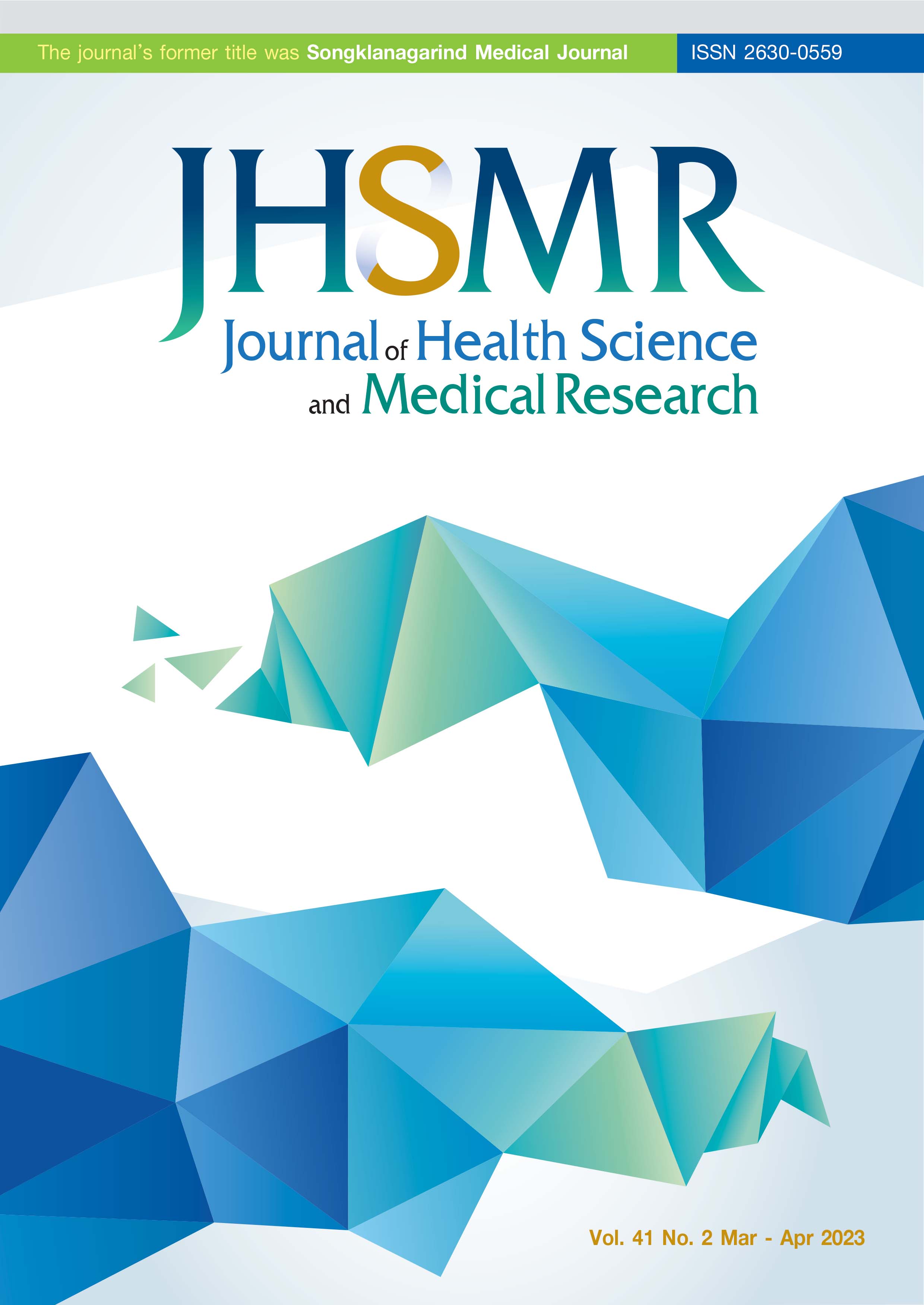Hearing Evaluation Post Canal Wall-Up (CWU) Tympanoplasty on Patients with Safe Type Chronic Suppurative Otitis Media
DOI:
https://doi.org/10.31584/jhsmr.2022909Keywords:
audiometry, CWU disease, otitis media, tympanoplastyAbstract
Objective: Otitis media is a contagious inflammatory illness of the middle ear that might have a sudden onset and a complete resolution, or it can have a persistent presentation and long-term implications. Surgical treatment is available for all kinds of otitis media. Different types of operations include canal wall-up, canal wall-down, and their variations. The wall-up approach of the two canals with or without posterior tympanotomies, also known as tympanoplasty surgery, preserves the rear wall of the ear canal.
Material and Methods: Hearing evaluation was conducted after canal wall-up tympanoplasty surgery at the outpatient clinic, Department of Otorhinolaryngology, Dr. Soetomo Hospital, Surabaya, Indonesia over a period of two years (2018-2019).
Results: Two hundred and thirty-seven patients underwent from January 1,2018 to December 31,2019. However, only 74 (31.2%) of them had complete medical records after surgery. Fifty-nine ears (79.7%) experienced a better hearing threshold, six ears (8.1%) did not improve, and nine ears (12.2%) deteriorated. The hearing threshold improvement was of a magnitude of 10.9 dB; before surgery, it was 56.6 dB, and after surgery, it became 45.6 dB.
Conclusion: A 10.9-dB improvement in hearing threshold mean was observed among patients undergoing canal wall-up tympanoplasty, whereas the bone gap improvement between pre- and post-tympanoplasty was 6.9 dB.
References
de Albuquerque MAS, de Andrade JSC, Godofredo VR, Matos RC, de Oliveira Penido N. Intratemporal complications of otitis media. Braz J Otorhinolaryngol 2013;79:141–9.
de Azevedo AF, de Castro Soares AB, Garchet HQC, de Sousa NJA. Tympanomastoidectomy: comparison between canal wall down and canal wall-up techniques in surgery for chronic otitis media. Int Arch Otorhinolaryngol 2013;17:242–5.
Batni G, Goyal R. Hearing outcome after type i tympanoplasty: a retrospective study. Indian J Otolaryngol Head Neck Surg 2015;67:39–42.
Benson J, Mwanri L. Chronic suppurative otitis media and cholesteatoma in Australia’s refugee population. Aust Fam Physician 2012;41:978–80.
Chapparbandi R, Mithun S, Chapparbandi S. Audiometric evaluation of tympanoplasty for hearing improvement. J Evol Med Dent Sci 2015;413814–23.
Islam MS, Islam R, Bhuiyan MA, Rashid S, Datta PG. Pattern and degree of hearing loss in chronic suppurative otitis media. Bangladesh J Otorhinolaryngol 2010;16:96–105.
Boronat-Echeverría NE, Reyes-García E, Sevilla-Delgado Y, Aguirre-Mariscal H, Mejía-Aranguré JM. Prognostic factors of successful tympanoplasty in pediatric patients: a cohort study. BMC Pediatr 2012;1267.
Hayati R, Haryuna TSH, Zahara D. Hearing Threshold Differences between pre and post tympanoplasty in patients with chronic suppurative otitis media. Bali Med J 2018;7:47.
Heywood R, Narula A. The pros and cons of canal wall up versus canal wall down mastoidectomy for cholesteatoma. Otorhinolaryngologist 2013;6:140–3.
Kim HC, Yoo MH, Kang WS, Ahn JH, Chunget JW. Factors influencing hearing outcomes after ossiculoplasty using polycel® prosthesis in patients with chronic otitis media. J Hear Sci 2011;1:40-4.
Kolo ES, Ramalingam R. Hearing results post tympanoplasty: our experience with adults at the KKR ENT Hospital, India. Indian J Otolaryngol Head Neck Surg 2014;66:365–8.
Lin AC, Messner AH. Pediatric tympanoplasty: factors affecting success. Curr Opin Otolaryngol Head Neck Surg 2008;16:64–8.
Mittal R, Lisi CV, Gerring R, Mittal J, Mathee K, Narasimhan G, et al. Current concepts in the pathogenesis and treatment of chronic suppurative otitis media. J Med Microbiol 2015;64:1103– 16.
Muftah S, Mackenzie I, Faragher B, Brabin B. Prevalence of chronic suppurative otitis media (CSOM) and associated hearing impairment among school-aged children in Yemen. Oman Med J 2015;30:358–65.
Quérat C, Martin C, Prades JM, Richard C. Canal wall up tympanoplasty for cholesteatoma with intact stapes. Comparison of hearing results between cartilage and PORP on stapes and impact of malleus removal and total reinforcement of the tympanic membrane by cartilage. Eur Ann Otorhinolaryngol Head Neck Dis 2014;131:211–6.
Shariff EA. Analysis of hearing loss by pure tone audiometry in patients with chronic suppurative otitis media. Natl J Physiol Pharm Pharmacol 2019;9:4.
Shrestha BL, Bhusal CL, Bhattarai H. Comparison of pre and post-operative hearing results in canal wall down mastoidectomy with type III tympanoplasty. JNMA J Nepal Med Assoc 2008;47:224–7.
Stankovic M, Stankovic P. Factors influencing the success of cholesteatoma surgery: a postoperative review. J Hear Sci 2011;1:40–4.
Yulius S, Asroel HA, Aboet A, Zaluchu F. Correlation of matrix metalloproteinase-9 (MMP-9) expression and bone destruction in chronic suppurative otitis media (CSOM) patients with cholesteatoma at Adam Malik General Hospital Medan Indonesia. Bali Med J 2018;7:195–200.
Najoan R, Purnami N. Validity of modified whisper test as hearing screening method in presbycusis patients. Indian J Otol 2021;27:11–3.
Busis SN. Presbycusis. Geriatric Otolaryngology. New York: Taylor and Francis Group; 2006.
Maharani D, Ferriastuti W. Chronic suppurative otitis media complicated by subdural and bezold abscesses: a case report. Radiol Case Rep 2022;17:1175–9.
Smith JA, Danner CJ. Complications of chronic otitis media and cholesteatoma. Otolaryngol Clin N 2006;39:1237-55.
Artono SR, Purnami N, Handoko E. Microbiological profile with antibiotic sensitivity pattern for chronic suppurative otitis media in a tertiary hospital, Indonesia. Res J Pharm Technol 2022;15:1683–8.
Bailey BJ, Johnson JT, Newlands SD. Head & Neck Surgery. Otolaryngology. Philadelphia: Lippincott Williams & Wilkins; 2006.
Downloads
Published
How to Cite
Issue
Section
License

This work is licensed under a Creative Commons Attribution-NonCommercial-NoDerivatives 4.0 International License.
























